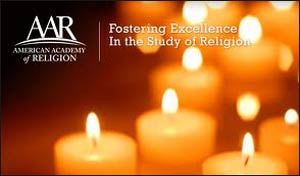By Jennifer Peace
THE INTERFAITH MOVEMENT & HIGHER EDUCATION
It all began when I sat next to Prof. Barbara McGraw at an Interfaith Youth Core conference in Chicago in 2009. We were both impressed by the energy and passion of the religiously diverse young people gathered to talk about models of interfaith cooperation. Having helped launch the IFYC in my younger days and now learning the ropes of academic life in my position at Andover Newton Theological School, it struck me how powerful it would be to combine the scholarly depth of the academy with the passion of the interfaith movement. Barbara looked at me and suggested simply, “what about starting a new area at the AAR (American Academy of Religion) focused on interfaith work?”
In 1995, when I began my doctoral studies at the GraduateTheological Union in the Historical and Cultural Study of Religions, there was no such thing as Interreligious or Interfaith Studies. While the “interfaith movement” has been a reality on the ground for many years (with a wide network of organizations), academia is notoriously restrained when it comes to recognizing new areas of study. But the picture is changing. A student starting at the GTU today can enroll in a Master’s degree in Interreligious Studies. Said student can get this same degree at Claremont Lincoln University, which prepares clergy for Christian, Jewish, and Muslim congregations. East Coasters can graduate from my seminary with a certificate in interfaith leadership or study to be an interfaith chaplain at Hartford Seminary. And this is just a small sample of the possibilities with new programs and faculty positions being created at an increasing rate.

Given this backdrop, the time seemed ripe to create a common platform for scholars from various undergraduate and graduate institutions to take a serious look at this emerging area from multiple disciplinary vantage points. So, following Barbara’s advice, I have been slowly working for several years to develop a proposal for a new area at the American Academy of Religions. At the 2011 AAR meeting in San Francisco, I convened a “wild card” session (a prerequisite for proposing any new area at the AAR) called, “Institutionalizing Interfaith.” The program included scholars from five different seminaries and rabbinical schools with innovative interreligious programming.
In the wake of the 2011 meeting, I found many enthusiastic new conversation partners. At the 2012 AAR meeting in Chicago I convened a group of interested scholars to discuss the scope and focus for this new area (fittingly, we held our meeting at the IFYC offices). Over 200 AAR members signed a petition in support of the planned group. A distinguished set of scholars, both established and emerging, signed on to the steering committee.
A religiously diverse group of established and emerging scholars joined the committee, including Diana Eck, Professor of Comparative Religion and Indian Studies at Harvard; Fredric Wertham, Professor of Law and Psychiatry in Society, also at Harvard; Paul Knitter, Tillich Professor of Theology, World Religions and Culture at Union Theological Seminary; John Makransky, Associate Professor of Buddhism and Comparative Theology at Boston College; Ravi M. Gupta, Associate Professor of Religious Studies at The College of William and Mary; and Rabbi Or Rose, Director, Center for Global Judaism, Hebrew College.
After many long hours of drafting a formal proposal for the new area with my co-chair Homayra Ziad, Assistant Professor of Islamic Studies at Trinity College, we submitted our plan to the Academy. Then we waited.
In December of 2012, the American Academy of Religions approved the new group called “Interreligious and Interfaith Studies.” Our first call for papers is posted in the January edition of Religious Studies News for panel presentations at the 2013 annual AAR meeting to be held in Baltimore, Maryland. For the next five years and renewable thereafter, this group will convene annually to: (1) expand and enrich the modalities of interreligious and interfaith discourse in a diverse set of academic disciplines that have grappled with religious pluralism, and (2) give voice to what has already been happening for years at the cutting edge of institutional and pedagogical innovation, and at the intersection of the academy and civic engagement in many disciplines.
In my dual appointment as both the Assistant Professor of Interfaith Studies and Co-director of the Center for Interreligious and Communal Leadership Education (CIRCLE) at Andover Newton, I’m reminded daily of the value of grassroots interfaith action coupled with research and reflection. I am grateful to have this new national platform at the AAR to connect and compare notes with other academics and practitioners who classify their own scholarly interests under the rubric of “Interreligious and Interfaith Studies.”
For further information about the new area, you can contact: Jennifer Peace or Homayra Ziad or visit the AAR website.

